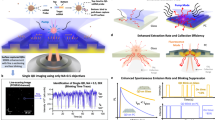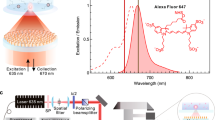Abstract
Sensors that are able to detect and track single unlabelled biomolecules are an important tool to understand biomolecular dynamics and interactions as well as for medical diagnostics operating at their ultimate detection limits1,2,3,4,5,6,7. Recently, exceptional sensitivity has been achieved using the strongly enhanced evanescent fields provided by optical microcavities2,4,5,8 and plasmonic resonators1,6,7. However, at high field intensities, photodamage to the biological specimen becomes increasingly problematic9,10,11,12. Here, we introduce an evanescent biosensor that operates at the fundamental precision limit due to the quantization of light. This allows a four orders of magnitude reduction in optical intensity, while maintaining state-of-the-art sensitivity. It enables quantum noise-limited tracking of single biomolecules as small as 3.5 nm, and monitoring of surface–molecule interactions over extended periods. By achieving quantum noise-limited precision, our approach provides a path towards quantum-enhanced single-molecule biosensors.
This is a preview of subscription content, access via your institution
Access options
Access Nature and 54 other Nature Portfolio journals
Get Nature+, our best-value online-access subscription
$29.99 / 30 days
cancel any time
Subscribe to this journal
Receive 12 print issues and online access
$209.00 per year
only $17.42 per issue
Buy this article
- Purchase on Springer Link
- Instant access to full article PDF
Prices may be subject to local taxes which are calculated during checkout




Similar content being viewed by others
References
Dantham, V. R. et al. Label-free detection of single protein using a nanoplasmonic–photonic hybrid microcavity. Nano Lett. 13, 3347–3351 (2013).
Zhu, J. et al. On-chip single nanoparticle detection and sizing by mode splitting in an ultrahigh-Q microresonator. Nat. Photon. 4, 46–49 (2010).
Li, B.-B. et al. Single nanoparticle detection using split-mode microcavity Raman lasers. Proc. Natl Acad. Sci. USA 111, 14657–14662 (2014).
Vollmer, F., Arnold, S. & Keng, D. Single virus detection from the reactive shift of a whispering-gallery mode. Proc. Natl Acad. Sci. USA 105, 20701–20704 (2008).
Baaske, M. D., Foreman, M. R. & Vollmer, F. Single-molecule nucleic acid interactions monitored on a label-free microcavity biosensor platform. Nat. Nanotech. 9, 933–939 (2014).
Zijlstra, P., Paulo, P. M. R. & Orrit, M. Optical detection of single non-absorbing molecules using the surface plasmon resonance of a gold nanorod. Nat. Nanotech. 7, 379–382 (2012).
Pang, Y. & Gordon, R. Optical trapping of a single protein. Nano Lett. 12, 402–406 (2012).
Kim, E., Baaske, M. D., Schuldes, I., Wilsch, P. S. & Vollmer, F. Label-free optical detection of single enzyme-reactant reactions and associated conformational changes. Sci. Adv. 3, 1603044 (2017).
Mirsaidov, U. et al. Optimal optical trap for bacterial viability. Phys. Rev. E 78, 021910 (2008).
Sowa, Y. et al. Direct observation of steps in rotation of the bacterial flagellar motor. Nature 437, 916–919 (2005).
Landry, M. P., McCall, P. M., Qi, Z. & Chemla, Y. R. Characterization of photoactivated singlet oxygen damage in single-molecule optical trap experiments. Biophys. J. 97, 2128–2136 (2009).
Wäldchen, S., Lehmann, J., Klein, T., Van de Linde, S. & Sauer, M. Light-induced cell damage in live-cell super-resolution microscopy. Sci. Rep. 5, 15348 (2015).
Knittel, J., Swaim, J. D., McAuslan, D. L., Brawley, G. A. & Bowen, W. P. Back-scatter based whispering gallery mode sensing. Sci. Rep. 3, 2974 (2013).
Lu, T. et al. High sensitivity nanoparticle detection using optical microcavities. Proc. Natl Acad. Sci. USA 108, 5976–5979 (2011).
Swaim, J. D., Knittel, J. & Bowen, W. P. Tapered nanofiber trapping of high-refractive-index nanoparticles. Appl. Phys. Lett. 103, 203111 (2013).
Yu, X.-C. et al. Single nanoparticle detection and sizing using a nanofiber pair in an aqueous environment. Adv. Mater. 26, 7462–7467 (2014).
Taylor, M. A. et al. Biological measurement beyond the quantum limit. Nat. Photon. 7, 229–233 (2013).
Kitamura, K., Tokunaga, M., Iwane, A. H. & Yanagida, T. A single myosin head moves along an actin filament with regular steps of 5.3 nanometres. Nature 397, 129–134 (1999).
Piliarik, M. & Sandoghdar, V. Direct optical sensing of single unlabelled proteins and super-resolution imaging of their binding sites. Nat. Commun. 5, 4495 (2014).
Park, S., Choi, S. Q., Song, C., Kim, M. W. & Choi, M. C. Surface charge effects on optical trapping of nanometer-sized lipid vesicles. Soft Matter 10, 8406–8412 (2014).
Stoylov, S. P. et al. Electric dipole moments of Escherichia coli HB 101. Bioelectrochemistry 75, 50–54 (2009).
Larsen, A. E. & Grier, D. G. Like-charge attractions in metastable colloidal crystallites. Nature 385, 230–233 (1997).
Armani, A. M., Kulkarni, R. P., Fraser, S. E., Flagan, R. C. & Vahala, K. J. Label-free, single-molecule detection with optical microcavities. Science 317, 783–787 (2007).
Baaske, M. D. & Vollmer, F. Optical observation of single atomic ions interacting with plasmonic nanorods in aqueous solution. Nat. Photon. 10, 733–739 (2016).
Sun, V. & Armani, A. M. Real-time detection of lipid bilayer assembly and detergent-initiated solubilization using optical cavities. Appl. Phys. Lett. 106, 071103 (2015).
Fazal, F. M. & Block, S. M. Optical tweezers study life under tension. Nat. Photon. 5, 318–321 (2011).
Mayor, U., Johnson, C. M., Daggett, V. & Fersht, A. R. Protein folding and unfolding in microseconds to nanoseconds by experiment and simulation. Proc. Natl Acad. Sci. USA 97, 13518–13522 (2000).
Taylor, M. A. & Bowen, W. P. Quantum metrology and its application in biology. Phys. Rep. 615, 1–59 (2016).
Taylor, M., Knittel, J. & Bowen, W. P. Optical lock-in particle tracking in optical tweezers. Opt. Express 21, 8018–8024 (2013).
Bachor, H. A. & Ralph, T. C. A Guide to Experiments in Quantum Optics (Wiley, 2004).
Acknowledgements
This work was supported by the Australian Research Council Discovery Project (contract no. DP140100734) and by the Air Force Office of Scientific Research and Asian Office of Aerospace Research and Development (grant no. FA2386-14-1-4046). W.P.B. acknowledges support through the Australian Research Council Future Fellowship scheme FF140100650. M.A.T. is supported by a fellowship from the Human Frontiers Science Program. The authors also thank B.-B. Li, J. D. Swaim and Y. Gagnepain for useful discussions.
Author information
Authors and Affiliations
Contributions
W.P.B. conceived and led the project. M.A.T. contributed towards the conceptual design. N.P.M. performed the experiments and data analysis, with contributions from L.S.M. Samples were prepared by N.P.M. and M.W. The manuscript was written by N.P.M., W.P.B. and L.S.M.
Corresponding author
Ethics declarations
Competing interests
The authors declare no competing financial interests.
Supplementary information
Supplementary information
Supplementary information (PDF 6703 kb)
Rights and permissions
About this article
Cite this article
Mauranyapin, N., Madsen, L., Taylor, M. et al. Evanescent single-molecule biosensing with quantum-limited precision. Nature Photon 11, 477–481 (2017). https://doi.org/10.1038/nphoton.2017.99
Received:
Accepted:
Published:
Issue Date:
DOI: https://doi.org/10.1038/nphoton.2017.99
This article is cited by
-
From artificial intelligence to semi-creative inorganic intelligence: a blockchain-based bioethical metamorphosis
AI and Ethics (2024)
-
Highly efficient channeling of single photons into guided modes of optical nanocapillary fibers
Optical and Quantum Electronics (2024)
-
Submonolayer biolasers for ultrasensitive biomarker detection
Light: Science & Applications (2023)
-
Fundamental quantum limits of magnetic nearfield measurements
npj Quantum Information (2023)
-
Quantum multiparameter estimation with multi-mode photon catalysis entangled squeezed state
Frontiers of Physics (2023)



